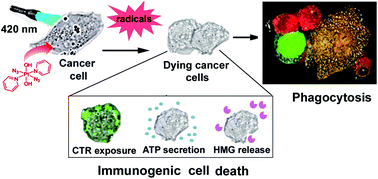Induction of immunogenic cell death in cancer cells by a photoactivated platinum(iv) prodrug†
Abstract
The platinum(IV) prodrug trans,trans,trans-[Pt(N3)2(OH)2(py)2] (1) is stable and non-toxic in the dark, but potently cytotoxic to cancer cells when irradiated by visible light, including cisplatin-resistant cells. On irradiation with visible light, it generates reactive Pt(II) species which can attack DNA, and produces reactive oxygen species (ROS) and reactive nitrogen species (RNS) which exert unusual effects on biochemical pathways. We now show that its novel mechanism of action includes induction of immunogenic cell death (ICD). Treatment of cancer cells with 1 followed by photoirradiation with visible light induces calreticulin (CRT) expression at the surface of dying cancer cells. This is accompanied by release of high mobility group protein-1B (HMGB1) and the secretion of ATP. Autophagy appears to play a key role in this chemotherapeutically-stimulated ICD. The observed uneven distribution of ecto-CRT promotes phagocytosis, confirmed by the observation of engulfment of photoirradiated CT26 colorectal cancer cells treated with 1 by J774.A1 macrophages. The photoactivatable prodrug 1 has a unique mechanism of action which distinguishes it from other platinum drugs due to its immunomodulating properties, which may enhance its anticancer efficacy.



 Please wait while we load your content...
Please wait while we load your content...